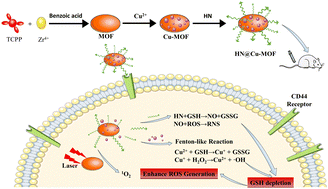All-in-one HN@Cu-MOF nanoparticles with enhanced reactive oxygen species generation and GSH depletion for effective tumor treatment†
Abstract
Non-invasive cancer therapies, especially those based on reactive oxygen species, including photodynamic therapy (PDT), have gained much interest. As emerging photodynamic nanocarriers, metal–organic frameworks (MOFs) based on porphyrin can release reactive oxygen species (ROS) to destroy cancer cells. However, due to the inefficient production of ROS by photosensitizers and the over-expression of glutathione (GSH) in the tumor microenvironment (TME), their therapeutic effect is not satisfactory. Therefore, herein, we developed a multi-functional nanoparticle, HN@Cu-MOF, to enhance the efficacy of PDT. We combined chemical dynamic therapy (CDT) and nitric oxide (NO) therapy by initiating sensitization to PDT and cell apoptosis in the treatment of tumors. The Cu2+-doped MOF reacted with GSH to form Cu+, exhibiting a strong CDT ability to generate hydroxyl radicals (˙OH). The Cu-MOF was coated with HN, which is hyaluronic acid (HA) modified by a nitric oxide donor. HN can target tumor cells over-expressing the CD44 receptor and consume GSH in the cells to release NO. Both cell experiments and in vivo experiments showed an excellent tumor inhibitory effect upon the treatment. Overall, the HN@Cu-MOF nanoparticle-integrated NO gas therapy and CDT with PDT led to a significant enhancement in GSH consumption and a remarkable elevation in ROS production.

- This article is part of the themed collection: Functional Framework Materials for Biomedical Applications


 Please wait while we load your content...
Please wait while we load your content...